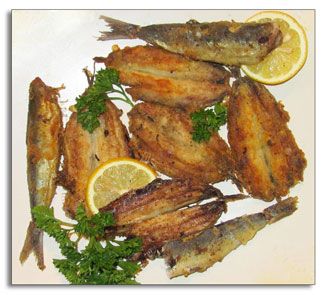|
|
The other fish in the seaby Ari LeVaux Wild-caught seafood is in high demand, but many wild fish stocks are dwindling while prices, understandably, are climbing. Certain fishing methods damage underwater ecosystems and create bycatch, whereby the wrong fish are caught and killed. Another problem with wild-caught fish at the top of the food chain, like tuna and swordfish, is they are known to accumulate dangerous levels of heavy metals and other dangerous chemicals in their fat. But sardines’ fishiness is the reason some people will pay 10 times more for mercury-tainted swordfish, thanks to a cultural preference we have about fish. We don’t want fish to smell or taste fishy. We like fresh, clean fish that doesn’t smell like anything, and tastes like whatever kind of fish it is. Old fish will smell fishy, which only nostrils more finely tuned than the average American’s can distinguish from the smell of rotten fish. Sardines are inherently fishy – even good, fresh, clean specimens. And in a rare disconnect between smell and taste that’s also characteristic of fine stinky cheeses, the fishiest of sardines can still taste fabulous, provided you follow the golden rule. The delectability of sardines is not completely overlooked, as they are America’s second-most-popular canned fish after tuna. And we can look to those cans for guidance on how best to manage sardines’ fishiness while enjoying their flavor. Submerging sardines in oil or water contains the smell, even after the can is opened. Herring, a big brother to the sardine, is often pickled, which balances the fish’s oiliness and also submerges the smell. Anchovies, the sardine’s little brothers, are the smelliest of all. They are often salted for storage, and it turns out that rubbing sardines with salt before you clean them will dissolve the fishy slime that coats the body. Then rinse with your choice of culinary acid (lime, white wine, vinegar) followed by water. This is worth doing to all fresh sardines, regardless of the recipe you intend to follow, and works in other fishy contexts. How sardines are cooked influences how powerfully the aroma will roam. Days after I once marinated and pan-fried a pound of sardines, visitors were still asking: fish for dinner? Marinated sardines are best cooked outside, on the grill, where the fat can drip and the fishy steam can disperse. Avoid long-simmering sardine soups. Perhaps the most popular way to cook sardines is to bread and fry them. The breading seals in the fishiness, allowing you to eat without smelling – assuming you aren’t covered in splattered grease. Fried sardines are common in many Mediterranean countries, and can be used as ingredients in other dishes. Fried fish simmered in rich, acidic sauce is called escabeche in Brazil and Portugal; fried sardines can also be pickled. I once put some leftover fried sardines in a jar of dill pickles in the fridge for a few days. I would do it again. Preparing fresh sardines: If they haven’t been scaled, do so gently with a knife. Then rub with salt and rinse with water and/or culinary acid. Clean out the guts, removing the head and/or bones if desired. You can also pull their heads off, gently, toward the belly, so that the bones and guts come out with the head, attached. This trick yields two boneless filets held together by the skin. Rinse again. Air or pat dry, then sprinkle with salt and pepper and roll in flour. Heat an inch of olive oil on low in a pan, and when a drop of water invokes a splatter, add the fish. Three minutes per side should do it, though you can cook them longer if you want a browner crisp at the expense of moist flesh. Fried sardines are typically served with lemon wedges or a dipping sauce like aioli, and little else. But the alternatives are many, such as cooking fried sardines in a Thai green curry, or stuffing into a po-boy. Sardines are caught the world over, and tasting imported canned sardines is fun. Another advantage of Pacific sardines, meanwhile, fresh or canned, is that efforts were made to release the bycatch alive, according to Seafood Watch, which ranks the Pacific sardine a “Best Choice” among seafood options. This is also a reflection of the health of the Pacific sardine fishery, which is currently in a boom phase of the decades long boom-and-bust cycle. The boom is good for Australian tuna farmers, who purchase most of the California sardine harvest. And hey, some of that farmed tuna might be available at your local sushi bar. For the price of a gallon of sardines you could buy a sliver of tuna. But you’d be better off going with the sardines, which are available now through fish suppliers – but you might have to convince your local market to carry some. Fishmongers, like many cooks and eaters, are wary of sardines. But they can be trained. If you can find sardines for sale, look for bright, sturdy specimen with clear eyes. Take them home, rip their heads off, and enjoy a rare taste of a wild animal from a population that isn’t crashing. |
In this week's issue...
- September 11, 2025
- Back on top
After harrowing flying accident, local highliner steps back out with renewed mission
- September 11, 2025
- New order
Rule change for Land and Water Conservation Fund raises alarms
- September 4, 2025
- Armed with knowledge
Local community organizers work to ensure immigrant neighbors know their rights


